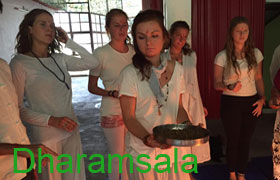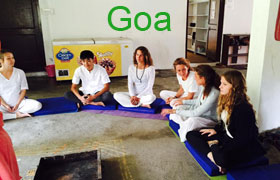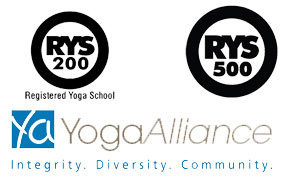Description of Six Chakras
Mooladhara chakra, swadhisthana chakra, manipura chakra, anahat chakra or hruday chakra, vishuddhi chakra or kanta chakra, agnya chakra or bhu chakra and sahasra chakra or shasra ila kamala are the seven chakras that reside in our body. Out of these the first six are called chakras but the seventh is not considereda chakra. It is generally denoted as sahasradal kamal or shiva sthan.
Mooladhara Chakra
Moola means the origin and adhara means foundation. Thus this chakra forms the original basis for all the remaining chakras. Mooladhara also denotes the starting point of the sushumna nadi that is near the vagina. It located slightly above the anus. This chakra is also known as adhara chakra or adhara kamala. It represents the earth element. In other words it is considered the bhulok residing in our body. The initial part of the mantra pertaining to pranayama that is “Om Bhu” means to awaken this chakra. It means to activate this chakra with all your power. This chakra is considered to possess four petals which are reed in colour. And each petal is engraved with vam, sham, sham, sam beeja mantras in order. The beeja mantras indicate this specific center of consciousness with the specific knowledge base. The central part is engraved with the beeja mantra “lam” which denotes the earth element. It means that this chakra I directly related to the earth element and once an individual accomplishes this stage he will be no more affected with the disorders of earth element. This element is characterised by smell. Consequently the seeker will be armoured with divine smell which means he will acquire the ability to fill his environment with the fragrance of his choice.
The means of conveyance of the beeja mantra “lam” on this chakra is considered to be airavata the elephant. The yoga tradition considers the awakening of this chakra as brahma granthi bhedan also.
Swadhishthana Chakra
Swadhidhthana chakra is located above the vagina and below the navel that is, it is located in between the mooladhara chakra and manipura chakra. This is considered to be the place of water element. It is the bhuvah loka in our body. This chakra is considered to be hexagonal and its color is considered to be the colour of sindoor. Every petal of this chakra is engraved with the beeja mantras bam, bham, mam, yam, ram and lam.
Tatv beeja of this chakra is vam and its means of conveyance is considered to be the makar, the crocodile. Awakening of swadhishthan chakra results in the destruction of ego and fascination. It also endows a person with the ability to write prose or poems in any language of his choice.
Eventually the seeker will not be affected by the water element in any way. He will not be affected with its freezing temperature. He cannot be drenched in water or his throat cannot be dried up or he may not drown in water either. Water cannot become a reason for his death.
Manipura Chakra
Manipura chakra is located in the spinal cord near navel. This area is considered to be the place of fire element. Pranayama mantra “om swah” denotes this and mean to awaken this chakra. All the tissues in this area will get activated once this chakra is awakened. This chakra is considered to have ten petals. Each petal is engraved with the beeja mantras dam, dham, nam, tham, dam, dham, nam, pam, pham in order. Fire is the prime characteristic of this chakra. Thus the beeja mantra for the fire element “ram” is engraved on the centre of this chakra and mesha the ram is considered the means of its conveyance. This chakra is specially related (gyanendriya) eyes and (karmendriya) feet. Eventually the seeker will be divyarupsamvith that he will be able to identify himself in various divine forms.
Anahat Chakra
Anahat chakra is considered to be located near your heart. It is in between the manipura chakra and vishuddhi chakra. This place is the centre for air element. This is the mahah lok in our body. The main characteristic feature of this chakra is touch. Skin and the hands are the gyanendriya and karmendriya related to this chakra. Pranayama mantra “om mahaha” is considered to awaken this chakra. This chakra has 12 petals each one engraved with the beeja mantras jo, kam, kham, gam, gham, dam, cham, chham, jam, jham, nam, tam and tham in order. The air element beeja mantra yam is engraved in its center. It is green in colour and the means of conveyance for this chakra is deer.
Vishuddhi Chakra
Vishuddhi chakra is located in your throat. This is located in between the anahat and agnya chakras. This area is considered to be the center of ether element. This is the area of janah lok in our body. The main characteristic of ether element is sound. The production of sound also happens in the same area in our body that is throat. The ears and speech are the gnyanendriya and karmendriya related to this element. “om janah” is the pranayama mantra used to awaken this chakra. When this chakra awakens the seeker will be able to hear all the sounds produced very far away and also those that were produced in the past. This chakra has 16 petals each one engraved with am, aam, em, eem, um, uum, rum, ruum, lum, luum, yem, yeem, om, oum, am, aham beeja mantras in order. Ham is the beeja mantra related ether element and is engraved on the center of this chakra. It is considered to be smoky ash color. Awakening of this chakra enables the seeker to become as tranquil as the ether or sky. The limits of his wisdom extend to the limits of the sky. Therefore he becomes sarvagnya.
Agnya Chakra
Pranayama mantra “om tapah” is used to awaken this chakra. This chakra has two petals. They are engraved with ham and ksham beeja mantras in order. They both represent knowledge and will power respectively. When this chakra awakens the mind and soul will reach the highest position which is called the sahasra chakra or the sahsradal kamala. This area is the origin of total consciousness. Therefore there are no disturbances. It is quite calm and peaceful here. An individual who reaches this stage will not have any desire to achieve. In this stage yogi gets immersed in the eternal bliss. He gets merged with the supreme soul. Therefore he becomes the supreme spirit itself.In this context we have described about awakening of mooladhar, swadhishthana, manipura, anahat, vishuddhi and agnya chakras only. The awakening the seventh chakra name the sahasra chakra is not dealt. The reason being that once the agnya chakra is awakened; there would be no need for any practice because no he has attained the status of a yogi. He is no more a seeker. He is united with the supreme spirit. This is the final stage achieved after surpassing all the stages of the yoga. This is called the parama siddhi avastha. In this stage, the sun, wind, clouds etc gets into the control of the yogi. He will acquire the capability to rule over the entire universe. Therefore, when the seeker practices asanas, pranayama, mudras, bandhas, shiddhi kriya etc he will one day reach a stage where his kundalini shakti is activated which enables him to reach his final destination. The yoga teacher training in Dharmasala offers excellent course on
Kundalini.
The activation of kundalini does not only endows the yogi with divine powers and but also opens the doors to his ultimate goal. Thus the process that activates the kundalini is by nature not simple. Therefore this process of awakening kundalini is always learnt under supervision of a master. And the masters always imparted this knowledge only to the seekers who were eligible. This was the main reason that this process was never documented in any scriptures in detail. The seeker who reaches this stage will naturally become exceptionally phenomenal irrespective of his achievement of his final goal. His attitude with respect to every aspect life completely changes away. Therefore a person who reaches this stage becomes a role model for the mankind.




